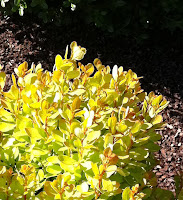Tiny Gold Adds color to G-Scale Model Rail Road Gardens, Rock Gardens, Containers & Borders
Tiny Gold Barberry (PP17084) is a truly diminutive woody shrub. Itty bitty gold leaves cover the cupcake-sized shrub 10 months of the year until winter. The small leaves attain best color in full sun, although this dwarf shrub also will grow in partial sun with a chartreuse leaf color. Brown twigs have deep grooves and a zig-zag appearance, with a sharp spine at each leaf node. Tiny Gold Barberry grows slowly to attain a mature spread of 12 to 15 inches with a maximum of 15 to 18 inches in height.
Insignificant pale yellow flowers bloom in late spring or early summer but do not set viable seed. Northern gardeners will be happy to learn that Tiny Gold Barberru is non-flowering, therefore the plant does not set viable seed and invasiveness is a non-issue with this cultivar.
Extremely adaptable, Tiny Gold grows in USDA Zones 5 to 9 in a wide range of soil types and exhibits average water needs, preferring well-drained soils; do not overwater. In the landscape, Tiny Gold is grown for its foliage color and pocket size.
Some landscape uses for Tiny Gold Barberry include mixed perennial borders, smaller more detailed gardens, miniature landscapes, G-scale model train landscapes and inclusion in containers for color.
Statistics Chart for Tiny Gold Barberry (PP17084) (Berberis thunbergii 'Tiny Gold')
Plant Category: | Dwarf deciduous woody shrub grown for its leaf color and tiny size |
Mature Height: | 6 – 18 inches |
Mature Spread: | 12 – 15 inches |
Mature Form: | True dwarf, rounded shrub |
Branching: | Brown branches deeply grooved, somewhat zig-zag in form and bearing a single sharp spine at each leaf node. |
Growth Rate: | Moderate, low maintenance, durable, no serious pests, resistant to rust |
Sun Exposure: | Full sun for best leaf color, will grow in partial shade |
Soil Type: | Widely adaptable, Loam, Sand or Clay |
Soil Moisture: | Well-drained; adaptable to drought when established |
Roots: | Wiry and yellow in color |
Flower: | Pale yellow in spring |
Berries: | Does not set viable seed, therefore not invasive, A patented plant will not come true from seed. |
Summer Leaf Color: | Bright, cheerful yellow to chartreuse |
Fall Color: | Lovely red-orange fall color, becoming deciduous in early winter ? |
pH Level: | 6.1 - 7.8 |
Hardiness Zones: | 5 - 8 |
Heredity: | Michal Andrusiv in the Czech Republic Registered in 2005 |
When performance counts, use Garden Debut® great new plants.
# # #












